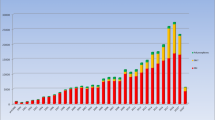Summary
By analyzing c-myc specific fragments from white blood cell DNAs of 98 gastric cancer patients and 46 control subjects, we observed 6 unexpected patterns due to presence of a variant c-myc gene in addition to the normal gene. Restriction enzyme mapping indicated that the variant c-myc gene was the result of a 5′ deletion including the first exon and part of the first intron. The deleted region, non-coding for the functional c-myc protein, contains sequences involved in the regulation of transcription. We therefore analyzed the c-myc mRNAs from a subject carrying the truncated gene and from a subject homozygous for the normal gene in Northern blotting experiments: the mRNAs were indistinguishable, both qualitatively and quantitatively. Family analysis demonstrated that the truncated gene is inherited in a Mendelian fashion. Population studies showed that the allele, both in patients and in control subjects, reaches a polymorphic frequency (2.1% for the whole sample) and that it is not associated with a risk of cancer.
Similar content being viewed by others
References
Auffray C, Rougeon F (1980) Purification of mouse immunoglobulin heavy-chain messenger RNAs from total myeloma tumor RNA. Eur J Biochem 107:303–314
Cesarman E, Dalla-Favera R, Bentley D, Groudine M (1987) Mutations in the first exon are associated with altered transcription of c-myc in Burkitt lymphoma. Science 238:1272–1275
Cole MD (1986) The myc oncogene: its role in transformation and differentiation. Annu Rev Genet 20:361–384
Dalla-Favera R, Wong-Staal F, Gallo RC (1982) Oncgene amplification in promyelocytic leukemia cell line HL-60 and primary leukaemic cells of the same patient. Nature 299:61–63
Dalla-Favera R, Martinotti S, Gallo RC, Erikson J, Croce CM (1983) Translocation and rearrangements of the c-myc oncogene locus in human undifferentiated B-cell lymphomas. Science 219:963–967
DelSenno L, Degli Uberti E, Rossi M, Buzzoni D, Barbieri R, Rossi P, Patracchini P, Bernardi F, Marchetti G, Conconi F, Gambari R (1986) Identification of a c-myc oncogene lacking the exon I in the normal cells of a patient carrying a thyroid carcinoma. FEES Lett 196:296–300
Feinberg AP, Vogelstein B (1983) A technique for radiolabeling DNA restriction endonuclease fragments to high specific activity. Anal Biochem 132:6–13
Gerosa MA, Talarico D, Fognani C, Raimondi E, Colombatti M, Tridente G, DeCarli L, Della Valle G (1989) Overexpression of N-ras oncogene and epidermal growth factor receptor gene in human glioblastomas. J Natl Cancer Inst 81:63–67
Haluska FG, Tsujimoto Y, Croce CM (1987) Oncogene activation by chromosome translocation in human malignancy. Annu Rev Genet 21:321–345
Hayday AC, Gillies SD, Saito H, Wood C, Wiman K, Hayward WS, Tonegawa S (1984) Activation of a translocated human c-myc gene by an enhancer in the immunoglobulin heavy-chain locus. Nature 307:334–340
Leder P, Battey J, Lenoir G, Moulding C, Murphy W, Potter H, Stewart T, Taub R (1983) Translocations among antibody genes in human cancer. Science 222:765–771
Peschle C, Mavilio F, Sposi NM, Giampaolo A, Caré A, Bottero L, Bruno M, Mastroberardino G, Gastaldi R, Testa MG, Alimena G, Amadori S, Mandelli F (1984) Translocation and rearrangement of c-myc into immunoglobulin α heavy chain locus in primary cells from acute lymphocytic leukemia. Proc Natl Acad Sci USA 81:5514–5518
Piechaczyc M, Blanchard JM, Marty L, Dani C, Panabieres F, Sabouty SE, Fort P, Jeanteur P (1984) Post-transcriptional regulation of glyceraldehyde-3-phosphate-dehydrogenase gene expression in rat tissues. Nucleic Acids Res 12:6951–6963
Ranzani GN, Salerno-Mele P, Maltoni M, Talarico D, Della Valle G, Amadori D (1988) Study of c-Ha-ras1 locus polymorphism in an Italian population with high incidence of gastric cancer. Mol Biol Med 5:145–153
Ranzani GN, Pellegata NS, Previderè C, Saragoni A, Vio A, Maltoni M, Amadori D (1990) Heterogeneous proto-oncogene amplification correlates with tumor progression and presence of metastases in gastric cancer patients. Cancer Res 50:7811–7814
Reed JC, Nowell PC, Hoover RG (1985) Regulation of c-myc mRNA levels in normal human lymphocytes by modulators of cell proliferation. Proc Natl Acad Sci USA 82:4221–4224
Spencer CA, LeStrange RC, Novak U, Hayward WS, Groudine M (1990) The block to transcription elongation is promoter deendent in normal and Burkitt's lymphoma c-myc alleles. Genes Dev 4:75–88
Watt R, Nishikura K, Sorrentino J, Ar-Rushdi A, Croce CM, Rovera G (1983) The structure and nucleotide sequence of 5′ end of the human c-myc oncogene. Proc Natl Acad Sci USA 80:6307–6311
Author information
Authors and Affiliations
Rights and permissions
About this article
Cite this article
Pellegata, N.S., Bergamaschi, G., Amadori, D. et al. A 5′-truncated c-myc gene variant not associated with a risk of cancer. Hum Genet 87, 579–582 (1991). https://doi.org/10.1007/BF00209016
Received:
Revised:
Issue Date:
DOI: https://doi.org/10.1007/BF00209016




